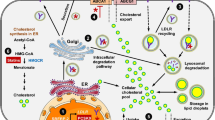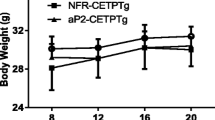Abstract
β-cell dysfunction is a critical step in the pathogenesis of type 2 diabetes. The mechanisms responsible for β-cell death and dysfunction remain incompletely understood, but include glucolipotoxicity, the deleterious metabolic milieu created by high plasma concentrations of glucose and lipid species. Recently, an important role has emerged for cholesterol in this process. In this article, we review recent advances in our understanding of the role of ABCA1 and cholesterol metabolism in β-cell function, with particular attention to insights gained from human studies.


Similar content being viewed by others
References
Papers of particular interest, published recently, have been highlighted as follows: • Of importance •• Of major importance
Perley MJ, Kipnis DM: Plasma insulin responses to oral and intravenous glucose: studies in normal and diabetic subjects. J Clin Invest 1967, 46:1954–1962.
Kahn SE: The importance of beta-cell failure in the development and progression of type 2 diabetes. J Clin Endocrinol Metab 2001, 86:4047–4058.
Prentki M, Nolan CJ: Islet {beta} cell failure in type 2 diabetes. J Clin Invest 2006, 116:1802–1812.
Unger RH: Lipotoxic diseases. Annu Rev Med 2002, 53:319–336.
Brunham LR, Kruit JK, Verchere CB, et al.: Cholesterol in islet dysfunction and type 2 diabetes. J Clin Invest 2008, 118:403–408.
von Eckardstein A, Schulte H, Assmann G: Risk for diabetes mellitus in middle-aged caucasian male participants of the PROCAM study: implications for the definition of impaired fasting glucose by the American Diabetes Association. J Clin Endocrinol Metab 2000, 85:3101–3108.
Timmins JM, Lee JY, Boudyguina E, et al.: Targeted inactivation of hepatic Abca1 causes profound hypoalphalipoproteinemia and kidney hypercatabolism of apoA-I. J Clin Invest 2005, 115:1333–1342.
Brunham LR, Kruit JK, Iqbal J, et al.: Intestinal ABCA1 directly contributes to HDL biogenesis in vivo. J Clin Invest 2006, 116:1052–1062.
Singaraja RR, Brunham LR, Visscher H, et al.: Efflux and atherosclerosis: the clinical and biochemical impact of variations in the ABCA1 gene. Arterioscler Thromb Vasc Biol 2003, 23:1322–1332.
• Brunham LR, Kruit JK, Pape TD, et al.: Beta-cell ABCA1 influences insulin secretion, glucose homeostasis and response to thiazolidinedione treatment. Nat Med 2007, 13:340–347. This article provides the first evidence that abnormal cholesterol efflux activity in islets leads to cholesterol accumulation and diminished insulin secretion.
Villarreal-Molina MT, Aguilar-Salinas CA, Rodriguez-Cruz M, et al.: The ABCA1 R230C variant affects HDL-cholesterol levels and body mass index in the Mexican population: association with obesity and obesity-related comorbidities. Diabetes 2007, 56:1881–1887.
Villarreal-Molina MT, Flores-Dorantes MT, Arellano-Campos O, et al.: Association of the ATP-binding cassette transporter A1 R230C variant with early-onset type 2 diabetes in the Mexican population. Diabetes 2008, 57:509–513.
Wang J, Burnett JR, Near S, et al.: Common and rare ABCA1 variants affecting plasma HDL cholesterol. Arterioscler Thromb Vasc Biol 2000, 20:1983–1989.
Koseki M, Matsuyama A, Nakatani K, et al.: Impaired insulin secretion in four Tangier disease patients with ABCA1 mutations. J Atheroscler Thromb 2009, 16:292–296.
Schaefer EJ, Brousseau ME, Diffenderfer MR, et al.: Cholesterol and apolipoprotein B metabolism in Tangier disease. Atherosclerosis 2001, 159:231–236.
Xia F, Xie L, Mihic A, et al.: Inhibition of cholesterol biosynthesis impairs insulin secretion and voltage-gated calcium channel function in pancreatic {beta}-cells. Endocrinology 2008, 149:5136–5145.
Xia F, Gao X, Kwan E, et al.: Disruption of pancreatic beta-cell lipid rafts modifies Kv2.1 channel gating and insulin exocytosis. J Biol Chem 2004, 279:24685–24691.
Vikman J, Jimenez-Feltstrom J, Nyman P, et al.: Insulin secretion is highly sensitive to desorption of plasma membrane cholesterol. FASEB J 2009, 23:58–67.
Kennedy MA, Barrera GC, Nakamura K, et al.: ABCG1 has a critical role in mediating cholesterol efflux to HDL and preventing cellular lipid accumulation. Cell Metab 2005, 1:121–131.
Yvan-Charvet L, Ranalletta M, Wang N, et al.: Combined deficiency of ABCA1 and ABCG1 promotes foam cell accumulation and accelerates atherosclerosis in mice. J Clin Invest 2007, 117:3900–3908.
Out R, Jessup W, Le Goff W, et al.: Coexistence of foam cells and hypocholesterolemia in mice lacking the ABC transporters A1 and G1. Circ Res 2008, 102:113–120.
Goldstein JL, Bose-Boyd RA, Brown MS: Protein sensors for membrane sterols. Cell 2006, 124:35–46.
Horton JD, Shimomura I, Brown MS, et al.: Activation of cholesterol synthesis in preference to fatty acid synthesis in liver and adipose tissue of transgenic mice overproducing sterol regulatory element-binding protein-2. J Clin Invest 1998, 101:2331–2339.
• Ishikawa M, Iwasaki Y, Yatoh S, et al.: Cholesterol accumulation and diabetes in pancreatic {beta}-cell-specific SREBP-2 transgenic mice: a new model for lipotoxicity. J Lipid Res 2008, 49:2524–2534. This article reports the results of mice that overexpress SREBP-2 specifically in β cells, leading to cholesterol accumulation and islet dysfunction.
Zeng L, Liao H, Liu Y, Lee TS, et al.: Sterol-responsive element-binding protein (SREBP) 2 down-regulates ATP-binding cassette transporter A1 in vascular endothelial cells. J Biol Chem 2004, 279:48801–48807.
Roehrich ME, Mooser V, Lenain V, et al.: Insulin-secreting beta-cell dysfunction induced by human lipoproteins. J Biol Chem 2003, 278:18368–18375.
Cnop M, Hannaert JC, Grupping AY, et al.: Low density lipoprotein can cause death of islet beta-cells by its cellular uptake and oxidative modification. Endocrinology 2002, 143:3449–3453.
Grupping AY, Cnop M, Van Schravendijk CFH, et al.: Low density lipoprotein binding and uptake by human and rat islet beta cells. Endocrinology 1997, 138:4064–4068.
Rutti S, Ehses JA, Sibler RA, et al.: Low- and high-density lipoproteins modulate function, apoptosis, and proliferation of primary human and murine pancreatic {beta}-cells. Endocrinology 2009, 150:4521–4530.
•• Drew BG, Duffy SJ, Formosa MF, et al.: High-density lipoprotein modulates glucose metabolism in patients with type 2 diabetes mellitus. Circulation 2009, 119:2103–2111. This article provides the first evidence that HDL-based therapies may have beneficial effects on islet function in humans.
Nissen SE, Tsunoda T, Tuzcu EM, et al.: Effect of recombinant ApoA-I Milano on coronary atherosclerosis in patients with acute coronary syndromes: a randomized controlled trial. JAMA 2003, 290:2292–2300.
Badimon JJ, Badimon L, Fuster V: Regression of atherosclerotic lesions by high density lipoprotein plasma fraction in the cholesterol-fed rabbit. J Clin Invest 1990, 85:1234–1241.
Miyazaki A, Sakuma S, Morikawa W, et al.: Intravenous injection of rabbit apolipoprotein A-I inhibits the progression of atherosclerosis in cholesterol-fed rabbits. Arterioscler Thromb Vasc Biol 1995, 15:1882–1888.
Shepherd J, Cobbe SM, Ford I, et al.: Prevention of coronary heart disease with pravastatin in men with hypercholesterolemia. N Engl J Med 1995, 333:1301–1308.
Freeman DJ, Norrie J, Sattar N, et al.: Pravastatin and the development of diabetes mellitus: evidence for a protective treatment effect in the West of Scotland Coronary Prevention Study. Circulation 2001, 103:357–362.
Ridker PM, Danielson E, Fonseca FA, et al.: Rosuvastatin to prevent vascular events in men and women with elevated C-reactive protein. N Engl J Med 2008, 359:2195–2207.
Rajpathak SN, Kumbhani DJ, Crandall J, et al.: Statin therapy and risk of developing type 2 diabetes: a meta-analysis. Diabetes Care 2009, 32:1924–1929.
Sugiyama S, Fukushima H, Kugiyama K, et al.: Pravastatin improved glucose metabolism associated with increasing plasma adiponectin in patients with impaired glucose tolerance and coronary artery disease. Atherosclerosis 2007, 194:e43–e51.
Tsutamoto T, Yamaji M, Kawahara C, et al.: Effect of simvastatin vs. rosuvastatin on adiponectin and haemoglobin A1c levels in patients with non-ischaemic chronic heart failure. Eur J Heart Fail 2009, 11:1195–1201.
Li S, Shin HJ, Ding EL, et al.: Adiponectin levels and risk of type 2 diabetes: a systematic review and meta-analysis. JAMA 2009, 302:179–188.
Chinetti G, Lestavel S, Bocher V, et al.: PPAR-alpha and PPAR-gamma activators induce cholesterol removal from human macrophage foam cells through stimulation of the ABCA1 pathway. Nat Med 2001, 7:53–58.
Wang J, Bao YQ, Hu C, et al.: Effects of ABCA1 variants on rosiglitazone monotherapy in newly diagnosed type 2 diabetes patients. Acta Pharmacol Sin 2008, 29:252–258.
Park SE, Kang ES, Kim DH, et al.: Effect of ABCA1 variant on atherogenic dyslipidaemia in patients with type 2 diabetes treated with rosiglitazone. Diabet Med 2009, 26:577–581.
Disclosure
This work was supported by grants from the Canadian Institutes of Health Research to Drs. Verchere and Hayden. Dr. Verchere is an Michael Smith Foundation for Health Research Senior Scholar. Dr. Hayden holds a Canada Research Chair in Human Genetics and is a University Killam Professor. No other potential conflicts of interest relevant to this article were reported.
Author information
Authors and Affiliations
Corresponding author
Rights and permissions
About this article
Cite this article
Brunham, L.R., Kruit, J.K., Hayden, M.R. et al. Cholesterol in β-cell Dysfunction: The Emerging Connection Between HDL Cholesterol and Type 2 Diabetes. Curr Diab Rep 10, 55–60 (2010). https://doi.org/10.1007/s11892-009-0090-x
Published:
Issue Date:
DOI: https://doi.org/10.1007/s11892-009-0090-x




